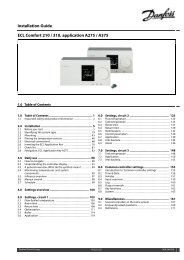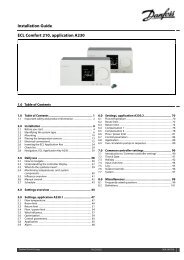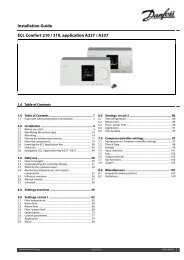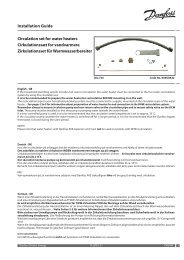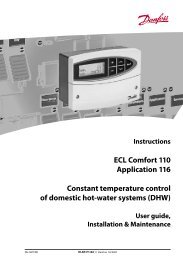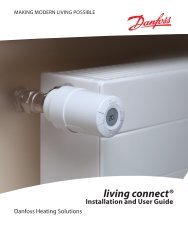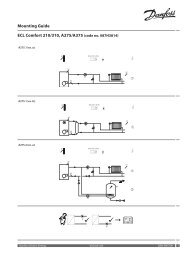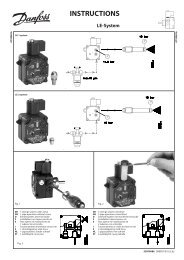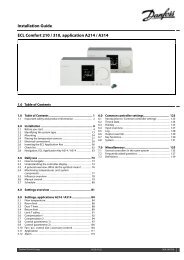ECL Comfort 110 Application 116 Constant temperature control of ...
ECL Comfort 110 Application 116 Constant temperature control of ...
ECL Comfort 110 Application 116 Constant temperature control of ...
You also want an ePaper? Increase the reach of your titles
YUMPU automatically turns print PDFs into web optimized ePapers that Google loves.
Motor prot. (motor protection) 6174<br />
Setting range Factory setting<br />
OFF / 10 ... 59 min. OFF<br />
Prevents the <strong>control</strong>ler from unstable <strong>temperature</strong> <strong>control</strong> (and resulting actuator oscillations). This<br />
can occur at very low load. The motor protection increases the lifetime <strong>of</strong> all involved components.<br />
OFF: Motor protection is not activated.<br />
10 ... 59:<br />
Motor protection is activated after the set activation delay.<br />
Xp (proportional band) 6184<br />
Setting range Factory setting<br />
1 ... 250 K 50 K<br />
Set the proportional band. A higher value will result in a stable but slow <strong>control</strong> <strong>of</strong> the<br />
flow <strong>temperature</strong>.<br />
Tn (integration time constant) 6185<br />
Setting range Factory setting<br />
5 ... 999 sec. 20 sec.<br />
Set a high integration time constant to obtain a slow but stable reaction to deviations.<br />
A low integration constant will make the <strong>control</strong>ler react fast but with less stability.<br />
M1 run (running time <strong>of</strong> the motorized <strong>control</strong> valve) 6186<br />
Setting range Factory setting<br />
5 ... 250 sec. 15 sec.<br />
‘M1 run’ is the time it takes the <strong>control</strong>led unit to move from fully closed to fully open<br />
position. Set the ‘M1 run’ according to the example.<br />
How to calculate the running time <strong>of</strong> a motorized <strong>control</strong> valve<br />
The running time <strong>of</strong> the motorized <strong>control</strong> valve is calculated using the following methods:<br />
Seated valves<br />
Running time = Valve stroke (mm) x actuator speed (sec. / mm)<br />
Example: 5.0 mm x 15 sec. / mm = 75 sec.<br />
Rotating valves<br />
Running time = Turning degrees x actuator speed (sec. / degr.)<br />
Example: 90 degr. x 2 sec. / degr. = 180 sec.<br />
16 VI.KT.F1.02 © Danfoss 05/2007 DH-SMT/DK<br />
Nz (neutral zone) 6187<br />
Setting range Factory setting<br />
1 ... 9 K 3 K<br />
Set the acceptable flow <strong>temperature</strong> deviation.<br />
Set the neutral zone to a high value if you can accept a high variation in flow<br />
<strong>temperature</strong>. When the actual flow <strong>temperature</strong> is within the neutral zone, the <strong>control</strong>ler<br />
does not activate the motorized <strong>control</strong> valve.<br />
The neutral zone is symmetrical around the desired flow <strong>temperature</strong> value, i.e. half the<br />
value is above and half the value is below this <strong>temperature</strong>.<br />
If you want to tune the PI regulation precisely, you can use the following<br />
method:<br />
• Set the ‘Tn’ (integration time constant line 6185) to its max. value (999 sec.).<br />
• Decrease the value for the ‘Xp’ (proportional band line 6184) until the system starts<br />
hunting with a constant amplitude (it might be necessary to force the system by setting<br />
an extreme value).<br />
• Find the critical time period on the <strong>temperature</strong> recording or use a stop watch.<br />
Temp. Critical time period<br />
DH-SMT/DK VI.KT.F1.02 © Danfoss 05/2007 17<br />
Time<br />
This time period will be characteristic for the system, and you can evaluate the settings from<br />
this critical period.<br />
‘Tn’ = 0.85 x critical time period<br />
‘Xp’ = 2.2 x proportional band value in the critical time period.<br />
If the regulation seems to be too slow, you can decrease the proportional band value by<br />
10%.



